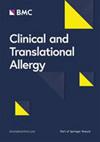Quality of life in type 2 and non-type 2 endotypes in chronic rhinosinusitis with nasal polyps: A prospective trial
Abstract
Background
In current clinical practice, primary diffuse chronic rhinosinusitis with nasal polyps (CRSwNP) is classified into two endotypes: type 2 and non-type 2. Previous studies on sinonasal health-related quality of life (HRQoL) in CRS have primarily focused on differences between phenotypes. This study aimed to compare HRQoL between the two endotypes in patients with CRSwNP.
The type 2 endotype had a higher median nasal polyp score (NPS) than non-types (4 and 2, respectively), but this difference did not reach significance. Loss of smell was associated with NPS, and facial pain/pressure was inversely correlated with age. Age was significantly associated with loss of smell, but only in non-type 2 CRSwNP.
Methods
This was a prospective, monocentric study conducted between 2018 and 2023 on CRSwNP patients referred for surgery. Health-related quality of life was assessed using the German standardized SNOT-20 questionnaire. Type 2 was defined according to the updated EPOS/EUFOREA 2023 criteria.
Results
A total of 122 patients with CRSwNP were included, 113 (92.6%) of whom were classified as type 2. Type 2 was associated with a significantly worse SNOT-20 German Adapted Version score. Two of the four cardinal symptoms of CRS—loss of smell and rhinorrhea—were significantly more severe and prevalent in the type 2 endotype, with loss of smell being very specific. The most prevalent symptom in both endotypes was nasal obstruction, with no difference between both endotypes.
The type 2 endotype had a higher median nasal polyp score (NPS) than non-types (4 and 2, respectively), but this difference did not reach significance. Loss of smell was associated with NPS, and facial pain/pressure was inversely correlated with age. Age was significantly associated with loss of smell, but only in non-type 2 CRSwNP.
Conclusion
Type 2 CRSwNP has a more severe impact on HRQoL compared with non-type 2 CRSwNP. Hyposmia, rhinorrhea, and potentially NPS may offer endotypic and pathophysiological insights.


 求助内容:
求助内容: 应助结果提醒方式:
应助结果提醒方式:


